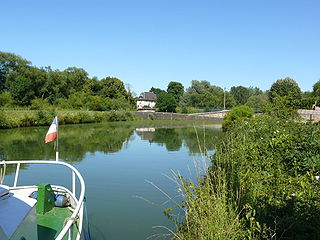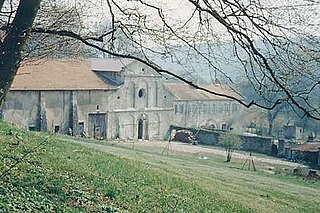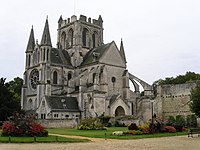
Aisne is a French department in the Hauts-de-France region of northern France. It is named after the river Aisne. In 2020, it had a population of 529,374.

The arrondissement of Laon is an arrondissement of France in the Aisne department in the Hauts-de-France region. It has 240 communes. Its population is 157,371 (2016), and its area is 2,175.3 km2 (839.9 sq mi).

Attigny is a commune in the Ardennes department in the Grand Est region of north-eastern France.

The Diocese of Amiens is a Latin Church diocese of the Catholic Church in France. The diocese comprises the department of Somme, of which the city of Amiens is the capital. In 2022 it was estimated that there was one priest for every 6,916 Catholics in the diocese.

The Diocese of Soissons, Laon, and Saint-Quentin is a Latin Church diocese of the Catholic Church in France. The diocese is suffragan to the Archdiocese of Reims and corresponds, with the exception of two hamlets, to the entire Department of Aisne. The current bishop is Renauld Marie François Dupont de Dinechin, appointed on 30 October 2015. In 2022, in the Diocese of Soissons there is one priest for every 5,594 Catholics.

Toul Cathedral is a Roman Catholic church in Toul, Lorraine, France. It is a classic example of late Gothic architecture in the Flamboyant style. The cathedral has one of the biggest cloisters in France.

Cœuvres-et-Valsery is a commune in the Aisne department in Hauts-de-France in northern France. The town is in the Arrondissement of Soissons.
The Congregation of St. Vanne or Congregation of St. Vanne and St. Hydulphe (French: Congrégation de Saint-Vanne et Saint-Hydulphe was a Benedictine reform movement centered in the Duchy of Lorraine. It was formally established in 1604 on the initiative of Didier de La Cour, prior of the Abbey of Saint-Vanne near Verdun, a reformer of the Benedictine Order after the Council of Trent. The Abbey of St. Hydulphe at Moyenmoutier was a secondary centre of the reform.

UNESCO designated the Routes of Santiago de Compostela in France as a World Heritage Site in December 1998. The routes pass through the following regions of France: Aquitaine, Auvergne, Basse-Normandie, Bourgogne, Centre, Champagne-Ardenne, Ile-de-France, Languedoc-Roussillon, Limousin, Midi-Pyrénées, Picardie, Poitou-Charentes, and Provence-Alpes-Côte d'Azur. UNESCO cites the routes' role in "religious and cultural exchange", the development of "specialized edifices" along the routes, and their "exceptional witness to the power and influence of Christian faith among people of all classes and countries in Europe during the Middle Ages".

Grestain Abbey was an 11th-Century Benedictine monastery near the town of Fatouville-Grestain, which is located in the modern-day Eure département of Upper Normandy, France. The abbey was in the Catholic Diocese of Lisieux. Closely associated with the family of William, Duke of Normandy, the abbey was instrumental in the Normans taking control over the Church in England in the centuries following the Norman Conquest of England, establishing new churches and priories in England, and Abbots of Grestain ordained many English priests. Many churches mentioned in the Domesday Book of 1086 cite Grestain as the founding establishment.

Saint-Yved is a church in Braine, Aisne in which the Counts of Dreux are buried. It was dedicated to Saint Yved, whose relics were brought to Braine (Braisne) in the ninth century. Originally a chapter of secular canons, the Braine Abbey was given to the Premonstratensian order by the Bishop of Soissons in 1130.

The Abbey of St. John, Laon was a Benedictine monastery in Laon, France, from 1128 to 1766, which replaced a nunnery founded in 641. The prefecture of the department of Aisne now occupies the site.

Sainte-Marie-au-Bois is a former abbey of the Premonstratensians order, located in the commune of Vilcey-sur-Trey, Meurthe-et-Moselle, France, built near a spring at the bottom of a small valley where a tributary of the Trey flows. Long considered the oldest settlement of the Premonstratensians order in Lorraine, its abbot in the early 17th century was Servais de Lairuelz, who led the reform of his order, first in Lorraine and then beyond. At the start of the First World War, French writer and poet Charles Péguy stayed at the former abbey, now a farm. Today, its remarkable remains make Sainte-Marie-au-Bois a rare architectural reminder of the Prémontré order in the 12th century.

















